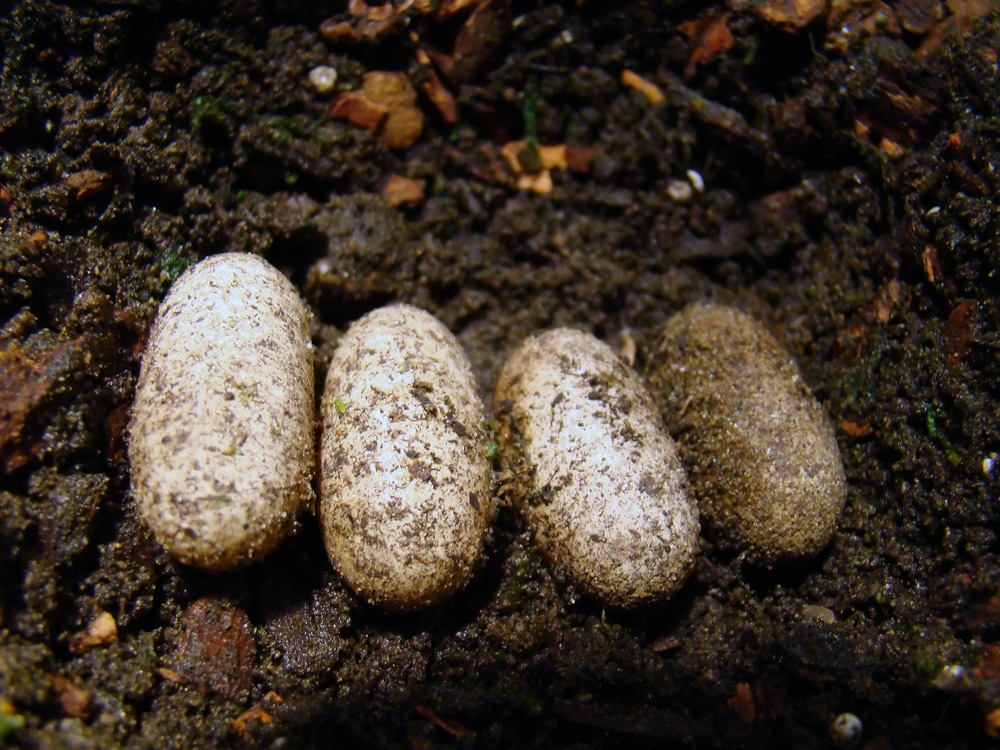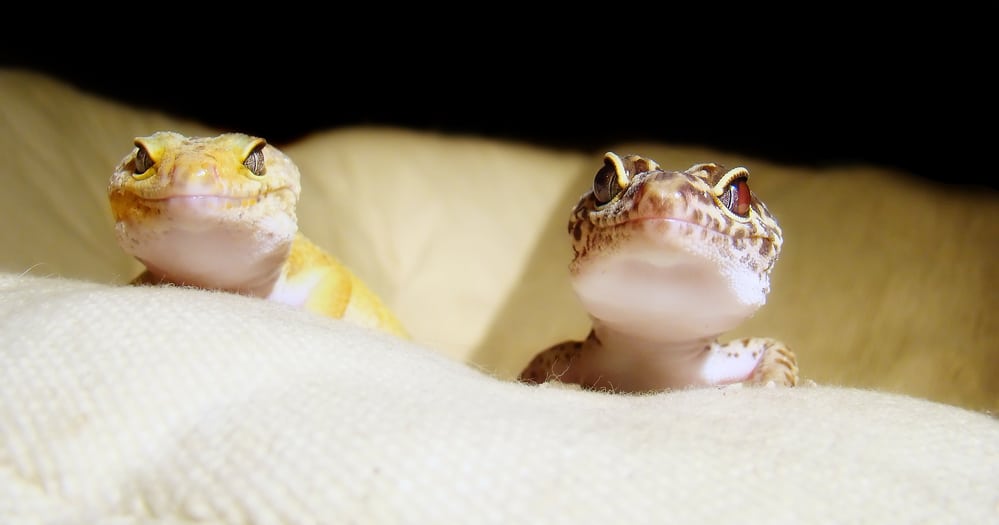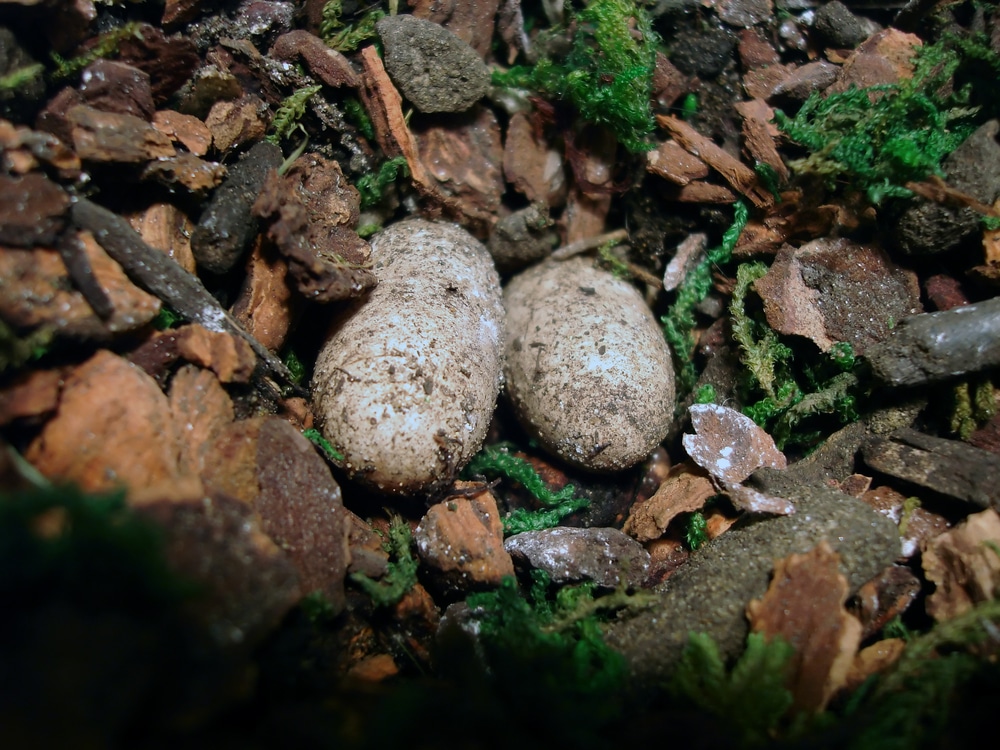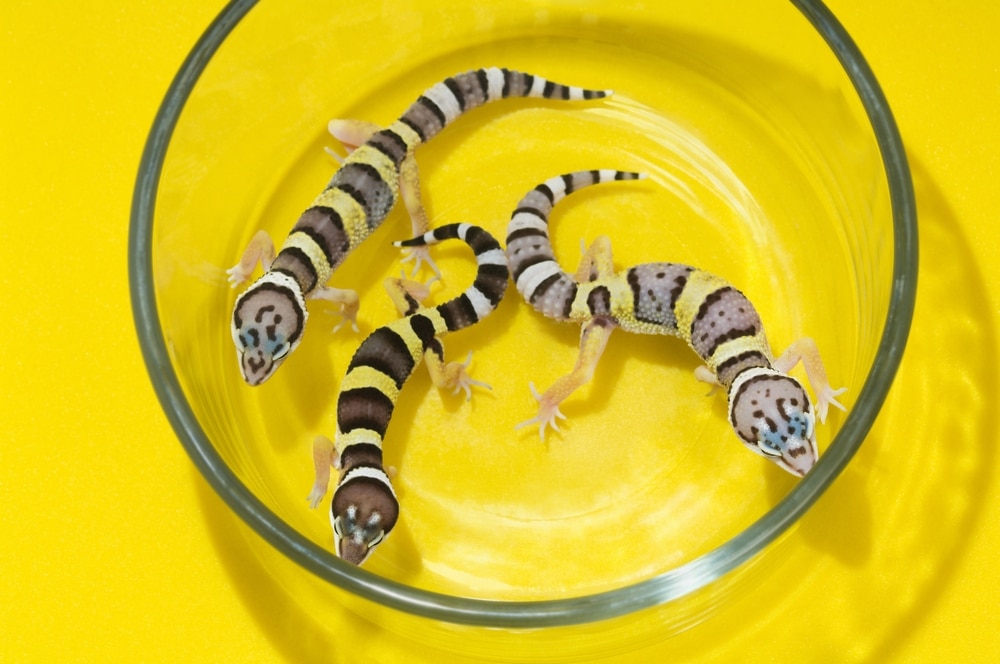Few lizards make better pets than leopard geckos (Eublepharis macularius). They’re small, without being so diminutive that they present husbandry challenges, they’re typically docile and easy to handle, and they are easy to house.
They’re also hardy lizards, who can tolerate many of the mistakes beginning keepers make, and they’re available in myriad color and pattern variations.
In fact, many of these traits also make leopard geckos ideal for another scenario: captive breeding programs. Leopard geckos are typically very easy to breed, and they make an excellent subject for keepers interested in breeding lizards themselves.

Below, we’ll discuss the basic things you’ll need to understand to breed your leopard geckos below, from sex determination to egg incubation to neonatal husbandry.
As long as you start with healthy animals and follow the tips discussed below, you should have no trouble joining the growing ranks of leopard gecko breeders.
Quick Navigation
Sexing Leopard Geckos

Obviously, the first thing you’ll need to breed leopard geckos is at least one mixed-sex pair. This means you’ll need to learn how to determine the sex of your lizards.
There are two primary criteria you can consider when trying to distinguish male leopard geckos from female leopard geckos.
To examine either, you’ll have to begin by gently flipping your lizard upside down. Alternatively, you can place your lizard in a clear-bottomed container and then raising the container over your head.
In either case, look for the presence of two things, which indicate that the lizard in question is male:
- Twin bulges along each side of the tail base. These are caused by the lizard’s hemipenes, which are held within the tail base when not in use. Female leopard geckos do not have these bulges.
- A V-shaped row of pores between the lizard’s legs. These pores are visually distinct and quite obvious in male lizards, but they are only faintly apparent in female lizards if they can be distinguished at all. Males will often have waxy secretions emerging from the pores.
It is always easier to learn how to determine the sex of any species by examining a large number of individuals. But if that isn’t possible, you may want to consider reviewing as many photos of the relevant region as possible.
Pre-Breeding Conditioning
Now armed with a matched set of leopard geckos, you’re ready to initiate your breeding program.
But the first step in this process does not involve breeding the lizards at all; first, you must ensure that they are both in the best possible health and physical condition.
Breeding can be taxing for the animals involved, so it is important that the animals start in tip-top shape.
This is especially true of the female, who’s body will not only have to cope with the physical trauma of the breeding process but also the demands egg deposition will place upon her body over the course of the season.
So, this means you’ll want to spend one to three months feeding the lizards heavily. Neither should be allowed to become grossly overweight, but you want them to have full, plump looking tails. You’ll also want to be sure you’ve provided enough supplemental calcium for the female during this time.
But before you begin this part of the process, have your veterinarian examine your intended breeders and screen them for illnesses or parasites. This way, you’ll have plenty of time to address such issues before pairing your animals.
Cycling
Cycling is a process that seeks to synchronize and prime your animals for a breeding season.
It usually involves artificially creating a “winter” or “dry season,” for one to two months, and then restoring normal “spring” or “summer” temperatures, day lengths and humidity levels. A short time later, pairings can begin.
In the case of leopard geckos, this means that you must stop feeding them for about one week so they can empty their digestive tracts, and then you’ll drop their temperatures to the low-70s.
Reduce the amount of daylight your lizards receive each day if possible, and be sure that you continue to provide water at all times.
Once you’re ready to conclude the cycling period, gradually restore normal conditions over the course of a few days and begin feeding the lizards heavily again.
However, leopard gecko breeders don’t always utilize a cycling period. Some keepers simply maintain relatively constant temperatures all year long and experience good results. So, you’ll just have to decide which approach you’d like to pursue.
Pairing
Once you’ve completed the cycling period and your lizards have enjoyed a week or two of normal conditions, you can begin pairing the lizards so that they can mate.
You can do so in a variety of different ways. Just be sure that your approach makes sense for your situation.
For example, some breeders pair the lizards for brief periods (lasting several hours to a full day) and then separate them again for a day or two of rest and recovery.
They’ll usually repeat this process throughout the breeding season, to ensure all clutches deposited by the female are fertile.
Other breeders simply leave their lizards in the same enclosure for the duration of the breeding season. Some even maintain their lizards together all year long. We highly recommend avoiding this, though, as it usually can causes geckos unnecessary stress at best, and lead to fights at worst.
As with the issue of cycling, you’ll simply have to decide which approach you’d like to embrace.
Egg Deposition
You’ll want to add an egg deposition container to the female’s habitat within about one week of the initial pairings.
A small plastic container works well, just cut a 2-inch-diameter hole in the lid to provide the lizard with access to the interior. Inside the container, add several inches of slightly damp (not wet) potting soil or vermiculite.

When ready, the female will crawl into the container and deposit two relatively large eggs. She’ll usually bury them, and then exit the chamber to drink water and rest.
She’ll continue to produce a new clutch once every two to three weeks, for the duration of the breeding season.
It is a good idea to pay special attention to the female following each clutch. Make sure she has water and a dish of calcium supplement powder available at all times and feed her heavily so that she can replenish her fat stores.
Egg Incubation
Once your female leopard gecko has deposited her eggs, you’ll need to retrieve them from the egg deposition chamber and transfer them to an incubator.
You can purchase an incubator or make one yourself – just be sure that it is capable of holding a consistent temperature for the duration of the incubation period.
Before you try to dig up the eggs, prepare an incubation container that will hold the eggs inside your incubator. A small plastic tub with a few small ventilation holes drilled in the side will work well. Fill the bottom of the container with damp (not wet) vermiculite.
Remove the eggs from the egg-deposition container carefully and mark the tops with a pencil. Use care to ensure that you place the eggs in an incubation container in the same orientation in which they were deposited so that you don’t cause the developing embryos to die.
Set your incubator to the desired temperature (more on this in a moment) and place the egg incubation container inside. Monitor the eggs throughout the incubation process but try not to disturb them too much.
If everything goes well, you should see the eggs begin to hatch in one to three months, depending in large part on the incubation temperature you choose. The higher the temperature selected, the quicker the eggs will hatch.
Incubation Temperatures
There is one important aspect of egg incubation that requires further discussion: the temperature at which you’ll incubate the eggs.
Leopard geckos exhibit a phenomenon known as temperature-dependent sex determination (TDSD). This means that eggs incubated at some temperatures will become male, while other temperatures will produce female lizards. Intermediate temperatures will produce a (statistical) mix of male and female lizards.
If you don’t care which sex emerges, you can simply incubate your leopard gecko eggs between 80- and 90-degrees Fahrenheit.
However, if you want to produce female geckos, you’ll want to keep the incubator at the lower end of this range (between about 80 and 84 degrees); if you want to produce all male geckos, incubate the eggs at the high end of this range (between 88 and 90 degrees).
Incubation temperatures of about 87 degrees will usually produce a mix of both sexes.
Note that these temperatures are not 100% guaranteed to produce the desired sex, but they usually do.
Neonatal Husbandry

With luck, you should eventually be greeted by the sight of hatching leopard geckos one day.
When you start seeing little geckos emerging from their eggs, it is time to set up a “nursery” habitat for their first week or so of life.
Different breeders utilize different designs for their hatchling’s first home (and some skip the “nursery” phase completely, and simply set their hatchlings up in enclosures that are just like adult enclosures, but smaller).
However, they are all broadly similar and feature a relatively spartan habitat, with only a paper towel substrate, a shallow water dish, and a few hiding spots.
This enclosure should be kept at about 80 degrees, and the humidity level should be slightly higher than that of an adult leopard gecko’s habitat.
Most leopard geckos will not eat until they shed their skin for the first time, which generally occurs about one week after hatching.
This is a good time to move your young hatchlings into their own individual enclosures, with typical leopard gecko temperatures and humidity levels.
You can also begin feeding the young lizards very small crickets at this time.
Leopard Gecko Breeding FAQs
We’ve tried to outline the general process for breeding leopard geckos above, but there are a number of questions about the process that may have gone unanswered.
So, we’ll try to answer some of the most common inquiries below.
How old do leopard geckos need to be before breeding them?
It is more important to consider a leopard gecko’s size and body condition than age when trying to determine if it is safe to use for breeding programs.
That said, it generally takes at least 9 months (and in some cases longer) for them to reach maturity.
How large does a female leopard need to be before breeding?
Generally speaking, females should weigh at least 45 grams before being used in breeding programs.
Females bred before reaching this size are likely to produce infertile or non-viable eggs, and they’re at increased risk of becoming egg-bound or suffering other problems.
When is the breeding season for leopard geckos?
Leopard geckos are likely capable of producing eggs at any point in the year, but most leopard geckos in the U.S., Canada or Europe breed between January and September.
How long does mating take for leopard geckos?
While the breeding season lasts about eight to nine months, and leopard geckos may copulate several times during this period, actual mating is a quick affair. It rarely lasts longer than 3 to 5 minutes.
How many eggs can a leopard gecko produce in a season?
Each leopard gecko is an individual, and different breeding program protocols will affect the lizards in different ways, but most female leopard geckos are capable of producing 8 to 10 eggs each season.
Do leopard geckos always deposit two eggs at a time?
Geckos typically produce two eggs at a time, but occasional clutches will consist of a single egg. This is most common among young or old female lizards, as well as those who’ve already produced a large number of eggs.
Can you keep leopard geckos together all year long?
It is generally accepted that you should never keep multiple leopard geckos together for an extended period of time. Cohabitation usually leads to stress and fighting.
Separating your geckos also helps ensure that the female gecko can rest and recover from the demands of the egg-laying season, which will help ensure her next season will be productive.
Do you have to use an incubator for leopard gecko eggs?
It is surely possible to allow your leopard gecko’s eggs to simply incubate in the egg-deposition container, but you will probably find that your hatching success rate falls.
It is also possible that the adult lizards will damage the eggs when they enter the egg-laying chamber.
Conclusion
Leopard geckos are one of the easiest lizard species to work with when you are trying to learn how to breed reptiles. So, don’t be afraid to give them a try.
If you follow the steps outlined above and enjoy a bit of good luck, you could be staring down at an enclosure full of brand-new baby leopard geckos before you know it.
Just be sure you’re ready to feed and house all of the lizards you helped bring into the world.